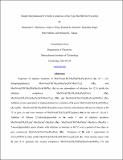Simple Molybdenum(IV) Olefin Complexes of the Type Mo(NR)(X)(Y)(olefin)
Author(s)
Marinescu, Smaranda C.; King, Annie J.; Schrock, Richard Royce; Singh, Rojendra; Muller, Peter; Takase, Michael K.; ... Show more Show less
DownloadMain article (1.663Mb)
PUBLISHER_POLICY
Publisher Policy
Article is made available in accordance with the publisher's policy and may be subject to US copyright law. Please refer to the publisher's site for terms of use.
Terms of use
Metadata
Show full item recordAbstract
Exposure of heptane solutions of Mo(NAr)(CHCMe2Ph)(Me2Pyr)(OAr) (1a; Ar = 2,6-diisopropylphenyl), Mo(NAr)(CHCMe3)(Me2Pyr)[OCMe(CF3)2] (1b), and Mo(NAr)(CHCMe2Ph)(Me2Pyr)(OSiPh3) (1c) to one atmosphere of ethylene for 12 h yields the ethylene complexes, Mo(NAr)(CH2CH2)(Me2Pyr)(OAr) (2a), Mo(NAr)(CH2CH2)(Me2Pyr)[OCMe(CF3)2] (2b), and Mo(NAr)(CH2CH2)(Me2Pyr)(OSiPh3) (2c). Addition of 1 equiv of triphenylsilanol to a solution of 2c gives Mo(NAr)(CH2CH2)(OSiPh3)2 (3) readily. Mo(NAr)(CHCMe2Ph)(OTf)2(dme) reacts slowly with ethylene (60 psi) in toluene at 80 °C to give cis and trans isomers of Mo(NAr)(CH2CH2)(OTf)2(dme) (4a) in the ratio of 2(cis):1. Addition of lithium 2,5-dimethylpyrrolide to 4a under 1 atm of ethylene produces Mo(NAr)(CH2CH2)(η1-Me2Pyr)(η5-Me2Pyr) (5a). Mo(NAr)(CHCMe2Ph)(η1-MesPyr)2 (MesPyr = 2-mesitylpyrrolide) reacts cleanly with ethylene in benzene at 60 °C over a period of four days to give exclusively Mo(NAr)(CH2CH2)(MesPyr)2 (5b). Treatment of 5b with 2 equiv of (CF3)2CHOH in ether yields Mo(NAr)(CH2CH2)[OCH(CF3)2]2(Et2O) (6). Neat styrene reacts with 2c and 3 to generate the styrene complexes, Mo(NAr)(CH2CHPh)(Me2Pyr)(OSiPh3) (7) and Mo(NAr)(CH2CHPh)(OSiPh3)2 (8), respectively. Similarly, the trans-3-hexene complex, Mo(NAr)(trans-3-hexene)(OSiPh3)2 (9a), can be prepared from 3 and neat trans-3-hexene. When 3 is exposed to 1 atm of ethylene, the molybdacyclopentane species, Mo(NAr)(C4H8)(OSiPh3)2 (10), is generated. X-ray structural studies were carried out on 2c, 5a, 6, 8, 9a, and 10. All evidence suggests that alkene exchange at the Mo(IV) center is facile, followed by cis,trans isomerization and isomerization via double bond migration. In addition, trace amounts of alkylidene complexes are formed that result in slow metathesis reactions of free olefins to give (e.g.) a distribution of all possible linear olefins from an initial olefin and its double bond isomers.
Date issued
2010-12Department
Massachusetts Institute of Technology. Department of ChemistryJournal
Organometallics
Publisher
American Chemical Society
Citation
Marinescu, Smaranda C. et al. “Simple Molybdenum(IV) Olefin Complexes of the Type Mo(NR)(X)(Y)(olefin).” Organometallics 29.24 (2010): 6816–6828.
Version: Author's final manuscript
ISSN
0276-7333
1520-6041